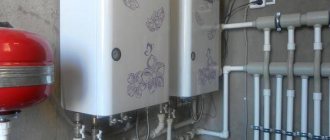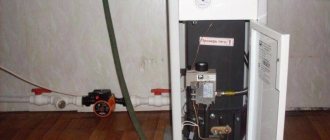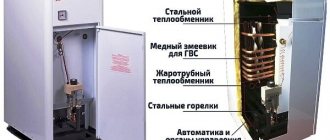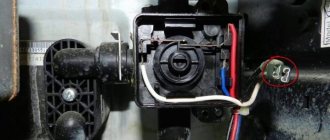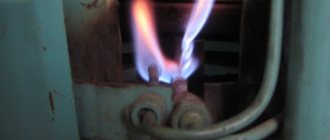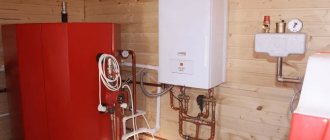The house has a gas boiler AOGV Siberia 17.4 with Eurosit 630 automation. A week ago it had a malfunction. The unit begins to fade as soon as the wind flow hits the ignition device. Not long ago I changed the thermocouple, but nothing changed. How to fix?
When the main burner turns on, this leads to a decrease in the supply of fuel to the ignition burner, which means that the automation is activated. You need to add fuel to the ignition mechanism. This happens mainly due to a drop in pressure in the heating system. In another case, the draft in the chimney weakened if it was installed incorrectly.
Tell me what the problem is if this device turns off, especially when there are strong gusts of wind and rainy weather outside. How should the problem be resolved?
When the igniter is started, the solenoid valve is forced to operate in approximately 20 seconds. When the ignition wick goes out, the solenoid valve turns off within ten seconds and a click will be heard.
Four years ago I installed an AOGV 17.4 Siberia boiler at the dacha. The house is small, area no more than 40 square meters. As you can see, the flow rate is small, but the water cannot heat up above 55 degrees. We have 2 radiators for 12 sections. Can't figure out how to increase the heating temperature?
To fix the problem, install a circulation pump. Sometimes there is a decrease in pressure in the gas line.
What causes the boiler to overheat systematically during use?
The main factor is that circulation in the heating circuit has stopped. It is also possible that the filter is clogged or there is an excessive amount of air in the heating system.
We have a problem. When we close the cold tap and open the hot water tap, water comes out of the heating system. What's happening?
Apparently your heating system feed tap is faulty. It allows water to move through both pipelines. If there is water pressure in the system, then movement in the opposite direction should not occur.
Why does the device make noise, gurgle, and at times howl and even clap?
The liquid in the system is very enriched with oxygen. When heated, air evaporates, which causes noise. If the unit settings are incorrect, the gas valve or bypass may howl. Strong pops during startup indicate problems with the ignition mechanism.
At the end of 2014, we installed the AOGV Siberia 11.6 boiler. About six months later a failure occurred. I'm trying to set the temperature, but it won't hold it. Explain what this is?
Perhaps the automation has failed, and when the temperature rises by 70 degrees, the nozzles turn off. You need to configure the automation for it to work correctly. Another factor may be that the selected power of the device is inappropriate relative to the heated area.
I installed this unit myself at the beginning of August. It runs on liquefied gas. Approximately 10 m3 was consumed in 4 months. Currently, there is an excess of soot deposits inside the device, and the main burner has also begun to smoke. Why does this happen?
Too much soot deposits in the combustion chamber indicate that the burner is not adjusted and the gas may not burn fully. It is also possible that the gas mixture may be of poor quality. To prevent the burner from smoking, it is necessary to carry out wet cleaning in a timely manner.
The same device is in use. During startup, the burner ignites and immediately goes out. I believe the igniter is faulty. How can I fix this problem?
It is necessary to check whether the sound of the ignition mechanism sparking is heard when the ignition cable is removed. If not, the ignition transformer must be replaced. If the sound appears, replace the igniter electrode or the burner itself.
I am asking for help to get rid of a certain problem. A floor-standing boiler AOGV 23.2 Siberia with automatic equipment 630 Eurosit was installed. At the moment of ignition, the main burner lights up intensely, but fades out within 10-12 seconds. Repeated procedure does not change the situation. Who has encountered this?
Initially check the functioning of the thermocouple and draft sensor. Perform circuit contact diagnostics. Carefully disassemble the igniter and clean it. Adjust the ignition mechanism to lower gas pressure. Perhaps the draft has become poor, so the igniter does not have enough air when igniting the main burner.
The torch began to smoke thoroughly and the burner burned continuously and did not go out. The temperature does not rise above the set temperature, while the fire continues to burn. A lot of burning. The gas organization explained that there was insufficient traction. How to fix it?
We assume that there is a lack of air. You must carry out maintenance. Disassemble the gas unit, clean and rinse the burner and jets. The heat exchanger needs to be cleaned from the outside.
Please tell us why the boiler smokes? What needs to be done to resolve this problem?
There may be weak draft in the combustion chamber. We recommend cleaning the smoke exhaust duct.
What can be done, tell me, when the AOGV 11.6 Siberia boiler stopped starting? I try to hold the control knob, press the ignition start button, then hold it for about 7 minutes, release it, and the device goes out.
The igniter tube may be clogged. If this problem occurs, service maintenance is required. It may also be oxidation of the terminals on the traction sensor. Remove the terminals and remove any deposits from them.
Malfunction of the gas boiler Siberia AOGV 11.6 with automatic Eurosit 630. When you press the igniter button, gas is not supplied to the burner device. What could be the reason?
If this key is pressed, gas is delivered exclusively to the ignition device; it is not allowed to be supplied to the main burner.
We installed the same device. I don't like the process of switching from the ignition mechanism to the main burner. It turns out several claps. Could there be some kind of malfunction?
Apparently, the automatic control should be adjusted based on gas pressure.
We have this unit equipped with an automatic 630 Eurosit, which automatically turns off when the temperature rises to about 70 degrees. Can anyone help fix the problem?
The traction sensor is probably starting to operate. It is necessary to inspect the chimney duct.
This device was installed at the dacha. At the beginning of the week the heat hovered at 40 degrees, but the fire continues to burn continuously. What could be the reason?
Probably, the gas supply tube from the automation unit on the burner, and also the burner nozzle, were clogged.
Just yesterday we had a problem with the gas boiler Siberia AOGV 23.2. Water began to flow. It worked properly for no more than 3 weeks. Tell me why the water is dripping?
Dripping may occur due to high systemic pressure. Perhaps the walls of the heat exchange device have also collapsed. Water hammer can also be a source of leakage in boilers.
At the dacha we would like to launch the same device. I’m interested in what the declared gas supply pressure (methane/propane) is for these models?
In this type of boiler devices, the standard gas supply pressure for methane/propane is 150.0/300.0 Pascal.
I had the same device installed. The other day there was a malfunction. The device starts, but does not heat in heating mode. What could have happened?
It looks like air has accumulated inside the batteries or there is excess scale in the heat exchanger. It needs to be washed.
We use the same device indoors. Until this morning I warmed without any questions. Now he has a breakdown. It overheats every day. How can I remove this damage?
Most likely, there was a blockage with scale, as a result of which the duct became clogged. You need to clean the device.
Recently a problem with the heating boiler was discovered. Was in use for only 2 weeks. Then suddenly it finished reaching the set temperature. Maybe someone can explain what's going on?
The gas pressure in your system is weaker than necessary. You need to check the gas valve. Looks like there's a lot of lube inside. Try clearing away the excess.
Explain how to pump up the expansion tank?
The expansion tank is inflated with a simple hand pump to the pressure required according to the instructions. Usually the norm is 1-1.5 bar. Before pumping up the expander, be sure to drain the coolant from the boiler. This is done through the drain fitting or through the water tap, turning off the hot water supply.
The Siberia AOGV 11.6 boiler does not start. When the start button is held down, the burner is in operating mode. But if you do not fix the button, the device turns off. What is the reason for the breakdown?
The thermocouple or gas valve appears to be damaged. There may also be a decrease in gas pressure at the inlet pipes. Sometimes there is insufficient voltage on the control board.
Please tell us what service work needs to be performed in case of conversion from liquefied gas to natural gas?
First you need to replace the nozzles on the main burner. Next, change the modulator supply voltage. And finally, adjust the pressure parameters at maximum and minimum.
How does a safety valve function in a heating system?
This valve, adjusted to the required pressure, protects the heating system. It is not permitted to use the safety valve to empty the system.
The pressure of the heating system periodically increases. We reduce the pressure in the expansion tank to a limit of 2.1-2.3 atm. Is it possible that the heating circuit water comes from the hot water supply pipes?
The increase in pressure in the heating system can be explained by two basic factors. The pressure for the expansion tank is not set. The make-up valve is leaking.
There is a problem. The start is very difficult. The igniter lights, but the main burner does not have a flame. I just can’t understand what is the reason?
Most likely there is a malfunction in the ignition device. We recommend servicing the boiler and cleaning the ignition unit.
Help me clarify the situation with the chimney duct? For 2 days now there has been backdraft, causing smoke to immediately enter the room. The chimney was made by me myself. It is a steel pipe. There's probably something wrong.
An important reason may be an incorrectly executed chimney design. The pipe may become contaminated with combustion products, which dramatically reduces its efficiency. In addition, it is recommended to check the ventilation in the house.
European companies are considered recognized leaders in the production of heating equipment.
However, their products have considerable flaws, which are generated by the very approach to creating heating boilers.
Overload with electronics, an abundance of unused or unclaimed functions and other excesses increase the price, but significantly complicate the operation of the units.
Domestic manufacturers prefer a completely different approach to the production of gas boilers, relying on the reliability and unpretentiousness of their models.
Let's consider one of the Russian models of gas boilers - Siberia.
Model Siberia 17
Siberia 17 floor-standing gas boilers are designed and manufactured by Rostovgazoapparat CJSC.
They have high reliability, which is created due to the simplicity of the design and the absence of multiple additional functions that complicate the design and create a heavy load on the unit components.
Siberia 17 boilers are single-circuit, since the designation of double-circuit models contains the letter “K” (combined).
The units are non-volatile, which significantly increases their reliability and stability. They are characterized by low fuel consumption, unpretentiousness, ease of control and quiet operation.
Price range
The cost of Siberia floor-standing models depends on the power and set of functions of this unit.
The general range is between 20-65 thousand rubles. At the same time, the delivery set includes only the boiler, gasket, instructions and packaging. The chimney and other additional accessories (if needed) will have to be purchased separately .
IMPORTANT!
It is not recommended to save on concluding a warranty agreement. It’s not that expensive, but it will allow you to quickly and freely solve a lot of problems.
What functions does it have?
The main function of the unit is to heat the coolant for the heating circuit of a private house or other premises.
Additional functions of the boiler are:
- Thermometer providing visual control of coolant temperature.
- Piezo ignition system.
- The presence of a two-stage burner, pilot (pilot) and main.
- Availability of gas, flame and draft control.
All components and blocks of the boiler are conveniently located and allow for easy maintenance or repair.
Technical characteristics of a gas boiler
Let's look at the technical characteristics of the single-circuit boiler Siberia 17:
| Options | Values |
| Boiler type | Gas convection |
| Installation type | Floor |
| Fuel type | Natural or liquefied gas |
| Functionality | Preparation of coolant for heating systems |
| Efficiency | 90 % |
| Serviced area (maximum) | 170 m2 |
| Boiler power | 17 kW |
| Power supply | Absent |
| Burner type | Atmospheric (open type) |
| Burner material | Stainless steel |
| Ignition type | Piezo |
| Chimney diameter | 125 mm |
| Weight | 59 kg |
| Dimensions | 850×280×560 mm |
| Guarantee period | 24 months |
| Service life with proper maintenance, maximum | 25 years |
What to look for when choosing?
Before purchasing a dual-circuit model, you should pay attention to five important indicators:
Combustion chamber type
There are devices with an open and closed combustion chamber. Appliances with an open chamber take air from the room, and combustion products are discharged through the chimney. For safety reasons, such a chimney must be at least 4 m in height. Since this consumes oxygen from the room, ventilation in such a house must be well organized.
With closed combustion, air is taken from the street, and combustion products are discharged outside at this moment. Thus, the oxygen in the room does not burn and the overall atmosphere is much more favorable. Models with a closed chamber are suitable for those who have poor ventilation in their home. They can also be installed in the kitchen or bathroom. Devices with a closed combustion chamber are the only possible option for apartment buildings.
Boiler type
There are classic (convection) and condensation devices.
Classic wall-mounted gas boilers with two circuits, the 2020 rating of which will be given below, generate heat only by burning gas. On average, their efficiency ranges from 85 to 95%.
Condensing appliances generate additional heat by condensing water vapor that is produced naturally during the combustion process. Thanks to this, the boiler efficiency increases and can range from 100 to 110%. Taking this into account, the condensing model can reduce gas consumption by 10 - 15%. This savings will be especially noticeable when using heated floors. If you really want to save on heating and water heating, then take a condensing model. Such models will definitely be included in our rating of wall-mounted double-circuit gas boilers in terms of reliability.
Heat exchanger material
The heat exchanger of the device can be made of the following materials:
- Cast iron. Used in the cheapest models. It generates heat quite well, but the efficiency usually does not exceed 90%. Boilers with cast iron heat exchangers are heavier and bulkier, which complicates their installation.
- Stainless steel. Suitable for budget and middle class. Stainless steel is quite durable and can be easily repaired if necessary. However, heat transfer is less than that of copper.
- Copper. Copper heat exchangers are installed in mid- and expensive-class models. They are durable and dissipate heat well.
If you want to take a classic model and are going to install it yourself, take it with a stainless heat exchanger. For underfloor heating and hot water supply, we recommend choosing a condensing type device with a copper heat exchanger.
Boiler power
On average, 1 kW of device power can heat about 8 m2 of area. Divide the total area you need to heat by 8 and get the required power. Add 1 kW for water heating. If you want to more accurately calculate the power of the device, use the formula that we provided for single-circuit boilers.
Availability of built-in boiler
A separate type of double-circuit boilers can be additionally equipped with a boiler for heating and, most importantly, storing water. Sometimes it is very convenient to have such a boiler, since if there is a strong drop in pressure in the pipeline, the boiler may simply not heat the water, but the water in the boiler will always be hot. Purchasing a model with a built-in boiler makes sense only in cases where there is a frequent drop in pressure in the city water supply. Otherwise, it's a waste of money.
Advantages and disadvantages
The advantages of the single-circuit floor-standing boiler Siberia 17 should be considered:
- Reliability, stability.
- Silence.
- Energy independence.
- Simplicity of design and control.
- Unpretentiousness, all maintenance consists of cleaning and checking traction.
- Low cost.
The disadvantages of boilers can be considered:
- Lack of hot water heating function.
- Some difficulty starting the boiler.
- Lack of a display showing the current operating mode and other parameters.
Equipment installation
Equipment installation must be carried out by a specialist. To do this, you will additionally need to obtain permission to install:
- Registration of permission;
- The gap between the wall and the equipment must be at least 3 cm;
- For a floor-standing unit, you will need to prepare a foundation;
- To prevent gas leakage, all connections must be carefully insulated;
- The boiler should be started up for the first time by a specialist;
- The company representative must provide the equipment with a warranty upon first start-up;
- If you connect an electric boiler, you will need to install the electrical network and water supply;
- When connecting heaters that are not volatile, additional equipment will need to be installed separately;
- If you connect it to the network using the “cascade” principle, you can increase the power several times. Thus, it is possible to connect all types of boilers;
- A piezoelectric element is used for ignition;
- Initially, the igniter lights, and then the main burner.
If condensation appears on the heat exchanger during the first start-up, this is not a problem. When the unit heats up, it will disappear.
Device
The main design elements of the Siberia 17 gas boiler are an open type burner combined with a steel heat exchanger.
Together they perform the main task - heat the coolant . At the exit from the heat exchanger, the liquid enters a three-way valve, where the colder “return” is mixed into the hot flow to obtain the desired temperature.
The prepared coolant flows by gravity into the heating circuit.
Water moves under the influence of convection currents, moving hot layers up and cold layers down.
Taking this into account, the system must be installed in compliance with the standard slope, ensuring coolant circulation.
If this is not possible, it is necessary to connect an external circulation pump, which will ensure more active flow movement. However, in this case, the energy independence of the boiler ceases.
Smoke removal also occurs naturally, using stove-type drafts. This is an important and crucial point, since weak draft will cause smoke in the premises and the impossibility of operating the boiler. Proper installation and connection of the chimney will help ensure the necessary conditions.
Design
Looking at the Siberia units, you can see that they are simple classic boilers. The design includes a water jacket and, in fact, the boiler itself. “Siberian” boilers are quite compact, which allows them to be located in absolutely any part of the house.
If we consider the design in more detail, then we need to say a few words about the grate, transversely located beams, and the lid.
- A grate is needed to achieve maximum effect. It helps to make the heat removal area larger.
- The beams are installed on the paths of flue gases. They direct heat into the heating system.
- The lid has holes where charcoal is usually placed.
For which rooms is it best suited?
The floor-standing gas boiler Siberia 17 is designed for heating rooms up to 170 m2.
This is a common size for a medium-sized private home, large apartment, office or commercial space, etc.
The purpose of the premises is housing or public purposes; such boilers are not suitable for industrial or production workshops due to fire safety or technological restrictions.
Drafts and instability of air flow can have a constant impact on draft, causing the boiler to shut down . This is the main factor limiting the use of units in production conditions.
Start-up and operating instructions
The launch is carried out after connecting communications and checking the tightness of all connections.
Needs to be attached:
- Heating circuit forward and return pipelines.
- Gas pipeline.
- Make-up pipeline.
- Chimney.
After connecting the communications, the system is filled with water until it flows out of the signal pipe.
Then open the gas valve, press the pointer handle (all the way) and at the same time press the piezo ignition button of the pilot burner . You must hold it for up to 1 minute until a flame appears on the pilot burner.
After this, the pointer knob is set to position 4, the main burner lights up and the boiler begins to function.
Operation of the units involves periodically cleaning them from dust and soot, changing the current temperature settings as desired, and monitoring the general condition of the system.
If unusual or alarming signs appear, turn off the gas valve and immediately call a technician from the service center to inspect and repair (adjust) the device.
Any independent intervention in the mechanism can cause an accident and failure of the equipment..
Installation of a Junkers instantaneous boiler
The operating instructions provide a detailed plan for connecting the water heater. In particular, the following is stipulated:
- installation is carried out exclusively by a qualified craftsman who has the appropriate work permit;
- the housing is installed strictly vertically and horizontally;
- the distance between the wall and the back of the case is 5 cm;
- the minimum distance to the bottom of the column from the floor is at least 80 cm;
- installation is carried out in accordance with the current SNiP and SP, in premises that meet the requirements for the placement of gas-consuming equipment;
- Junkers carries out the first start-up of an instantaneous gas water heater in the presence of a gas service inspector and the company making the connection.
Reviews
Let's consider what reviews about Siberia 17 gas boilers are left by the owners themselves, who have the most complete understanding of the operational features of the units:
Creating your own heating system can significantly reduce the cost of heating and hot water supply.
For owners of private houses, this is also an opportunity to independently determine the start and end time of the heating season, and adjust the heating mode according to their feelings and preferences, and not according to the operating conditions of public networks.
In addition, constantly growing housing and communal services tariffs are forcing us to look for alternative ways to solve problems with heat supply to housing.
To create autonomous heating systems, different types of boilers are used, but gas units are considered the most efficient.
Let's consider one of the examples of domestic heating equipment, which represents serious competition to European models - the Siberia gas boiler.
Special features of the automatic system
As mentioned above, all products are automated and have a number of special features:
- The Italian Eurosit system controls the temperature;
- The automated system has a piezoelectric ignition function;
- Automation blocks make it easy to control the system;
- Mechanism of draft and flame control;
- The automatic system optimally consumes gas through the optimal choice of burner function;
- No need to control the process of the combination valve;
All systems are independent of energy, so there is no need to connect to the electrical network, and this is very important for Russia. Constant network failures disable all heating systems
Burner: basic operating functions
The Siberia heating system burner differs from its competitors in its operating features:
- The system is made of stainless steel, so even at low gas pressure there is no burnout.
- The burner is made in Italy.
- The system is made from environmentally friendly materials, so there are no harmful substances in the exhaust gases.
- The burner is very easy to use. You don't need any skill to replace or clean the system.
- At the time of replacing the igniter and the main part of the burner, the system runs on liquid fuel.
A few words about the power that each system has its own. To figure out how much power is required for an area, you can calculate it - take 10 square meters. m per 1 kilowatt. This calculation says that the system will work to its maximum, so add 0.3 to the resulting figure. If you need to warm up a room of 100 sq. m., then you better choose the 11th model Siberia. Moreover, when choosing a heating system, you need to choose design features - material, location, finish. For less insulated rooms, you need to calculate 1.5–2 kW per 10 square meters. m., for warm rooms - 0.5–0.7 kW.
If you want to use the Siberia boiler not only for heating, but also for supplying hot water, then it is better to buy boilers with the letter name K. If you buy the boiler model K, then such a system can provide all the hot water needs for several people. If more than three people will use hot water, then you need to buy a powerful boiler.
How much space is needed to install the boiler?
wall and floor heating systems can be used
The boiler room may not be heated
It is also important to consider that more powerful Siberia models make noise during operation. Some manufacturers produce powerful floor systems with excellent heat and sound insulation, which are installed outside the boiler room - in the hallway or kitchen
Additional details of the system are:
Additional details of the system are:
- Cranes;
- Expansion tank.
How to save on heating?
Without the slightest loss in comfort, you can reduce fuel costs by 10%. Especially if you have a private house and you are going to carry out major renovations. The initial costs can be recouped even with basic tariffs, and the price of fuel will rise. Your invested money will pay off even faster.
The very first thing you can do is reduce the heat loss of the building. This is a whole range of works, installation of doors and windows, insulation of walls
After all the work has been carried out, thermal monitoring must be performed: it is important to check that heat does not penetrate through the cracks. There are special companies that check losses using thermal imagers
And the owner of a private house can purchase a remote thermometer
It is also very important to choose a boiler based on power and positive reviews. The more square meters you need to heat, the more carefully you need to pay attention to the heat calculation. And the owner of a private house can purchase a remote thermometer
And the owner of a private house can purchase a remote thermometer
It is also very important to choose a boiler based on power and positive reviews. The more square meters you need to heat, the more carefully you need to pay attention to the heat calculation. On the heating systems market, the Siberia brand is one of the best
Systems with high power are very expensive, but consumer reviews are still positive. They evaluate the quality of use and technical properties of heating devices
The Siberia brand is one of the best on the heating systems market. Systems with high power are very expensive, but consumer reviews are still positive. They evaluate the quality of use and technical properties of heating devices.
Gas boilers from Siberia
Siberia boilers are the brainchild of Rostovgazoapparat CJSC. The company produces a wide range of heating and water heating equipment; installations produced under the Siberia brand are far from the only models in the company’s arsenal.
The main advantage, which determines stable demand and high-quality operation of boilers, is a deep knowledge of the conditions and operating features of heating equipment in the countries of the former USSR.
The manufacturer has eliminated the most problematic areas in the design, creating non-volatile units capable of operating in the most difficult conditions . This advantage can only be truly appreciated by residents of Russia who have an understanding of winter frosts and the danger of being left without heating.
The company produces units that are optimally suited for use in small and medium-sized private houses, of which the vast majority are in our country. Low gas consumption and active use of natural physical processes make it possible to increase efficiency and simplify the design of units .
All Siberia units are floor-mounted. This allows you not to load the walls in residential premises and expands installation possibilities - floor-standing boilers can be placed anywhere, unlike wall-mounted structures .
Since the units are non-volatile, the type of gas burner is the same for all - open (atmospheric) type elements with natural smoke removal are installed (a conventional stove-type draft is used). This circumstance puts forward some requirements for the room - it is necessary to ensure high-quality ventilation and eliminate drafts.
The circulation of the coolant is also natural by default, which creates the need for proper installation of the heating system in compliance with the required slope of the pipelines.
However, it is possible to install an external circulation pump, which increases the speed of movement of the heating agent and significantly increases the overall efficiency of the boiler.
There are single- and double-circuit models. The former are intended only for preparing coolant in the heating circuit, the latter simultaneously heat batteries and hot water for household needs.
The second type of design is more preferable in a private home, but the gas consumption of such boilers is slightly increased.
Heater parameters
The high efficiency of the AOGV - up to 92% - means that the installation of this equipment will bring maximum heating efficiency, and this is due to the original design of the jacket. Boilers can operate in heating systems with forced or natural circulation of coolant, provided that the pressure in the system is at least 1.4 Atm. Such conditions can ensure a liquid temperature of +40/+90C.
The disadvantage of this equipment can be considered to be too much power - even the lowest-power boiler produced by the Zhukovsky plant is designed to heat an area of at least 200 m2, which means that in small houses its installation will be impractical and costly.
The burner in any modification and brand of boiler is made of stainless steel, so its durability is guaranteed. The jacket for hot water supply is made of copper, the body of the unit is coated with polymer or powder paint. Standard automation has temperature sensors and regulators to control the temperature of the coolant and prevent overheating of the boiler. The package also includes a thermocouple that controls gas flow and an air flow stabilizer, which serves to compensate for differences in air pressure during gusts of wind, and shuts off the gas in calm weather. Certificate of conformity for gas boiler AOGB
| Names | AOGB-11.6 | AOGBK-11.6 | AOGB-17.4 | AOGBK-17.4 | AOGB-23.2 | AOGBK-23.2 | AOGB-29 | AOGB-35 | AOGBK-35 |
| Indicators | |||||||||
| Rated power, kW | 11,6 | 11,6 | 17,4 | 17,4 | 23,2 | 23,2 | 29,0 | 29,0 | 35,0 |
| Consumption of main or bottled gas | |||||||||
| Main, m3/h | 1,19 | 1,19 | 1,75 | 1,75 | 2,32 | 2,32 | 2,95 | 3,56 | 3,56 |
| Balloon, kg/h | 0,865 | 0,865 | 1,215 | 1,215 | – | – | – | – | – |
| Heated area, square meters | 120 | 120 | 100-200 | 100-200 | 100-250 | 100-250 | 150-300 | 150-400 | 150-400 |
| Efficiency ≥ 90% | 90,0 | 90,0 | 90,0 | 90,0 | 90,0 | 90,0 | 90,0 | 90,0 | 90,0 |
| DHW consumption when heating water at 35°C, liters per minute | – | 3,5 | – | 3,5 | – | 7,0 | – | – | 10,0 |
| Thread on fitting, inches | 1/2 | 1/2 | 3/4 | 3/4 | 3/4 | 3/4 | 3/4 | 3/4 | 3/4 |
| Inlet/outlet | |||||||||
| To the heating system | 1/2 | 1/2 | 1/2 | 1/2 | 2 | 2 | 2 | 2 | 2 |
| To the DHW system | – | 1/2 | – | 1/2 | – | 1/2 | – | 1/2 | – |
| Diameter of gas outlet pipe, ≥ decimeters | 1,15 | 1,15 | 1,25 | 1,25 | 1,38 | 1,38 | 1,38 | 1,38 | 1,38 |
| Dimensions, cm | |||||||||
| Height | 86,5 | 86,5 | 86,5 | 86,5 | 85,0 | 85,0 | 85,0 | 85,0 | 85,0 |
| Width | 41,0 | 41,0 | 41,0 | 41,0 | 33,0 | 33,0 | 38,0 | 38,0 | 38,0 |
| Depth | 41,0 | 41,0 | 41,0 | 41,0 | 55,0 | 55,0 | 55,0 | 55,0 | 55,0 |
| Weight, kg | 43,0 | 47,0 | 49,0 | 52,0 | 56,0 | 72,0 | 65,0 | 80,0 | 82,0 |
| In models with a power of 23.2 29 and 35 kW - rectangular housing |
Single-circuit unit AOGV - design and dimensions
Popular models
Siberia boilers are available in two design types:
- With cast iron heat exchanger. The series is marked with the designation KCHGO. Only single-circuit models with power
- With steel heat exchanger. Single- and double-circuit models are presented (the latter are marked with the letter “K” - combined).
The power of the models is designed for use in small and medium-sized private homes.
Value ranges include 11, 16, 23, 29, and 35 kW. Models with a cast iron heat exchanger also have 40 and 50 kW units, designed for operation in larger rooms . All models are equipped with an open type gas burner, which are manufactured in Italy.
Equipped with piezo or electronic ignition systems. To control pressure, capillary-type pressure gauges installed on the boiler body are used.
Competitors
Table. Comparison with competitors and analogues Photo ModelRatingPrice
| sample in the Siberia 23 review | 4,5 | RUB 27,600 |
| Bosch Gaz 6000 W WBN 6000-18 N | 6,5 | RUB 30,589 |
| Navien DELUXE PLUS 16K | 6,8 | RUB 30,325 |
| BaltGaz NEVA 18 Turbo | 6,9 | RUB 28,500 |
| Borinskoe AKGV-23.2 Eurosit | 4,6 | RUB 26,050 |
| Lemax Premium-16B | 5,1 | RUB 28,400 |
| Conord KSts-GV-16S | 4,6 | 26,500 rub. |
| Conord KSts-GV-20S | 4,6 | RUB 26,337 |
| Conord KSts-GV-20N | 4,6 | RUB 26,750 |
| MORA-TOP Meteor PK24ST | 6 | RUB 26,200 |
Sources
- https://expert-dacha.pro/otoplenie/kotly-ot/gazovye-k/proizvoditeli-gaz-k/gk-siberiya/sib-23.html
- https://ExpertKotel.ru/cat/siberia/siberia-23
[collapse]
Specifications
Let's look at the parameters of Siberia boilers:
| Options | Values | ||||
| Siberia 11 | Siberia 16-17 | Siberia 23 | Siberia 29 | Siberia 35 | |
| Boiler type | Gas heating convection | ||||
| Feature Set | Heating and hot water supply | ||||
| Power | 11 kW | 16-17 kW | 23 kW | 29kW | 35 kW |
| Fuel type | Natural or liquefied gas | ||||
| Efficiency | 86-90 % | ||||
| Life time | Up to 25 years, subject to proper operation and periodic maintenance | ||||
| Gas consumption (maximum) | 3.75 m 3 /h | ||||
| Heat exchanger type | Steel, welded construction | ||||
| Burner type | Atmospheric carbon steel | ||||
| Power supply | Not required | ||||
| Dimensions | 850x280x560 | 850x280x560 | 850x380x560 | 850x380x560 | 850x380x560 |
| Weight | 56 kg | 59 kg | 65 kg | 70 kg | 90 kg |
Peculiarities
The Siberia 23 model has the following overall dimensions - 380x850x560 mm (WxHxD), while the weight is 65 kg. Installed on the floor in compliance with all necessary distances from the nearest walls.
Principle and main operating parameters. The convection type of device involves the generation of heat from gas combustion, while the boiler operates on natural gas (methane, consumption 2.3 cubic meters per hour).
The non-volatile operating principle does not require connection to the electrical network and this is a plus, but usually, with this scheme, ignition must be started manually, and the coolant must circulate naturally, without a pump. The downside is the lack of electronic fuel saving algorithms.
Primary heat exchanger. In the case of Siberia 23, steel is used, its advantages are budget cost, lightness and tolerance to shocks and deformations, disadvantages are a little more susceptible to corrosion, less durable, an approximate service life of 5-20 years, depending on the intensity of use.
Management and control
The Siberia 23 gas boiler is mechanically controlled, which means that the main parameters are adjusted only manually and, as a rule, there are few of them; there is no way to save fuel. The advantage is greater reliability than that of an electronic panel and less expensive repairs in case of breakdown.
A thermometer is necessary to monitor the temperature of the coolant in the boiler.
Protection systems
Gas control - a useful and necessary function of the burner automatically stops the gas supply if the flame goes out for any reason.
Connection
- The connecting size for the gas pipe is 3/4″.
- To connect the heating circuit - 2″.
Advantages and disadvantages
The advantages of the units include:
- Simplicity of design, absence of unnecessary parts.
- Energy independence, no need to connect electricity.
- Long service life - according to the manufacturer, it is 25 years if the operating rules are followed.
- Simple and intuitive controls.
- Low gas consumption.
The disadvantages of Siberia boilers are considered:
- Natural traction is unreliable and difficult to adjust.
- Coolant circulation needs to be enhanced using an external circulation pump.
- The lack of a self-diagnosis system creates the risk of late detection of problems.
Device
The main elements of Siberia gas boilers are a gas burner and a heat exchanger. They work in conjunction, the first is a source of thermal energy, and the second is a flow-through container in which the coolant is heated.
The heated liquid is removed from the heat exchanger and enters either a secondary heat exchanger (for dual-circuit models), where hot water is heated, or directly enters a three-way tap.
There it is mixed in a given proportion with colder water from the return line to obtain the required operating temperature. Then the OM is discharged by gravity or under the action of an external circulation pump into the heating circuit.
The gas burner has 2 stages - pilot (pilot) and main . The first serves to ignite the flame in the main burner and is started using the piezo ignition button. The second serves as the main source of thermal energy.
Smoke removal occurs under the influence of natural draft. To avoid smoke, the room must be equipped with high-quality ventilation; drafts or air currents that could extinguish the burner flame are excluded.
Types
According to the set of functions, Siberia boilers are divided into two large groups:
- Single-circuit . They provide only the preparation of coolant for the heating system.
- Dual-circuit . Capable of simultaneously heating coolant and hot water.
The first group has the simplest design, and the second has an additional heat exchanger.
The issue of heating hot water is solved simply - the hot coolant that has just left the heat exchanger enters the secondary one and transfers some of the thermal energy to the water.
This method does not require significant design complexity, which allows you not to increase the price and get maximum benefit from the operation of the unit.
How to turn it on?
The units are connected to communication systems after delivery and installation of the boiler at the designated location.
Needs to be attached:
- Heating circuit forward and return piping.
- Water supply pipeline (only for double-circuit boilers).
- Gas supply pipeline.
After connecting and checking the tightness of the connections, the system is filled with water.
The quantity is determined by the condition of the signal pipe coming out of the expansion tank - as soon as water flows from it, it means that the system is completely filled . Then check the presence of draft by placing a lit match under the gas exhaust box.
If the draft is normal, open the gas valve and set the pointer knob to the “pilot” position.
Press the thermostat knob all the way and at the same time press until it clicks and hold the piezo ignition button.
The procedure lasts up to 1 minute. If a flame does not appear on the pilot burner, check the gas equipment and try again until a positive result is obtained. Then the pointer knob is set to position 4, and when the main burner lights, the desired heating temperature is set.
General Information
… and hints on saving energy: When the regulator settings are altered the regulator reacts with a time lag. Every 20 sec- onds the processor compares all desired and actual values and carries out all necessary corrections with the necessary speed. The room in which the room temperature regulator is mounted (control room) determines the temperature for all other rooms. Ie the room temperature in the control room acts as a control input for the entire heating network. For this reason all thermostat regulated radiators located in the control room must be opened completely at all times. Otherwise the thermostat valves would reduce the heat sup- ply although the regulator constantly requires more heat (see also chapter 4.1). If in the adjoining rooms a lower temperature is wanted or if the radiator should be turned off completely, the (thermostatic) radiator valves must be set accordingly. Since the room where the room temperature regulator is mounted acts as a control room, any external heating sources (eg insolation, tiled stove, etc.) can result in insufficient heating of the remaining rooms (the radiators stay cold). In order to avoid this the room temperature sensor RF 1 can be used according to the notes in chapter 2.2, chapter 5.1 and chapter 6.7. When the room temperature is reduced during the day or during the night a lot of energy can be saved. If the room temperature is reduced by 1 K (°C) this can save up to 5% of energy. It is not recommended to let the temperature of daily heated rooms drop below +15°C. When the room is heated up again the comfort is diminished by the walls which are cooled down. So if one wants a real comfortable room temperature the regulator must be turned up and so a lot more energy is used up than is in case of an even heat supply. If the building has good thermal insulation it is possible that the set economic temperature is not reached. But even in this case energy is saved since the heating system is not activated. In this case the starting time for economical operating mode can be set earlier. Do not let windows stand ajar for airing the rooms since this would constantly withdraw heat from the room without improving the air in the room considerably. Do avoid continuous airing! It is better to air the room briefly but properly (open the windows completely). Set the temperature regulator to a lower value during airing. 15
Why does it go out?
The main reason should be considered a gas supply interruption . If the valve on the gas pipe is closed, or the pressure in the network is lost, the burner will go out.
First of all, it is necessary to determine how much the gas pressure corresponds to the operating values. In addition, external influence factors are possible.
The burner flame largely depends on the room conditions and the presence of draft in the smoke removal system.
If there are drafts in the room, the draft may be weakened or completely disappear. then the combustion mode changes sharply and the flame goes out. Another possible reason is the occurrence of reverse draft, which may be caused by strong gusts of wind or drafts in the building.
Main faults of Siberia
The simple design of these boilers does not cause serious malfunctions, especially when users carry out systematic maintenance of the main modules. For this reason, there is practically no interest in spare parts for Siberia gas floor equipment.
The most common operational failures are:
- The piezo igniter or the main burner device does not light well. The most common cause of this failure is poor traction. A possible reason for the lack of combustion is a clogged wick or base burner.
Sometimes there are problems with ignition - The pilot burner goes out after 5-15 seconds. This failure indicates reverse draft in the chimney. The reason for this is often an incorrectly designed gas duct: it is too short or too long and there is no deflector.
- The boiler unit does not raise the temperature of the heating water above 60 C. Most often, this occurs due to a clogged gas valve.
- Software failure E01, it indicates the absence of a torch. This can happen when the gas tap is turned off, there is a significant pressure drop in the gas network or surges in the electrical network.
- Failure E04 - pressure drop in the water system is less than 0.7 bar. As a rule, this is due to air locks, leaks, breakage of the expansion tank or safety relief valve.
User manual
The boiler must be periodically cleaned of soot and dirt by wiping the body with a damp cloth.
It is allowed to use ordinary detergents followed by wiping the surface with a dry cloth.
Once a year (or as necessary), the boiler is serviced, which consists of completely cleaning the burner, gas filter, heat exchanger and other parts from soot, soot and other contaminants. The tightness of all connections (especially gas connections), the quality of traction and other measures are also checked.
Maintenance must be carried out by service center employees.
About the manufacturer
The Siberia trademark is managed by Rostovgazoappart JSC in Rostov-on-Don, probably the largest domestic manufacturer, which also produces a relatively new model range of RGA boilers and the well-known AOGV.
The company was registered in 2002, but the plant where the boilers are produced has been in existence for two centuries; back in 1959 it produced the then legendary AOGV-80. All this says that, in theory, the company has extensive experience in the production of budget gas equipment, and the models are constantly in demand. In practice, boilers under the Siberia brand have really proven themselves to be reliable and problem-free, absolutely adapted to the domestic unstable gas pressure, which is not the cleanest coolant. Often in homes you can even find inexpensive models with a corrosion-resistant steel heat exchanger that operate for more than 10 years.
All models have an efficiency of 90%, which is the highest figure for such a simple design. Gas consumption is also quite low, although not comparable to more expensive Lemax models. For example, the maximum gas consumption of the most popular Siberia 11 (11.6 kW) is 1.18 m3/hour, for the 17.4 kW model it is 1.76 m3/hour.
Installation of floor-standing Siberia. Thick (4 mm) steel heat exchanger, the simplest design from reliable modules.
The manufacturer’s steel heat exchangers, although susceptible to corrosion, are known for their durability and, according to installation practice and owner reviews, often last 10, 12 or more years. The thickness of the heat exchanger steel is 4 mm versus the standard 3 mm in budget boilers from other manufacturers. The automation in floor-standing models is non-volatile, the well-known Italian EuroSit, installed on most domestic boilers. Standard and burner – Polidoro. Such a device means that there is simply nothing to break in the boiler and its service life, with proper operation, is limited only by the life of the heat exchanger.
Of course, there are also known shortcomings that are common to almost all models of the manufacturer. First of all, the owners note the need for constant cleaning: it is advisable to clean the heat exchanger, burner and igniter annually (this takes about an hour), some owners clean the boiler 1-2 times a year using a light cloth and a vacuum cleaner (in general, it is advisable to keep the boiler room clean) . If the boiler modules are clogged, problems with ignition and operation of the automation may occur.
Also, owners often note that the burner igniter is noisy, the clicks (pops) are too loud when ignited, so the boiler must be placed in a separate room.
Otherwise, all models, taking into account their cost, even in comparison with other leading domestic analogues, are devoid of significant shortcomings (otherwise it would be strange, given a hundred years of production experience). Almost all models have been in trouble-free operation for more than 10 years, without causing serious service complaints.
Owner reviews
For a more correct and balanced presentation of information, you should use independent sources.
The owners of Siberia boilers are people who are not interested and are able to give information about them as they see it.
Consider user reviews:
No review found! Insert a valid review ID
Judging by the reviews, most users are quite satisfied with their boilers. Complaints and complaints about low-quality units are found always and everywhere, but it is impossible to say for sure what the true reason for the poor performance of the equipment is.
Experts unanimously claim that Siberia is the best domestic gas boiler.
